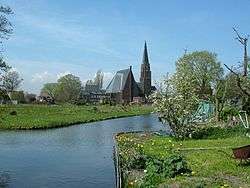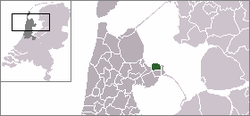Andijk
Andijk (![]()
Andijk | |
|---|---|
Village and former municipality | |
 | |
 Flag  Coat of arms | |
 | |
| Coordinates: 52.75°N 5.22°E | |
| Country | Netherlands |
| Province | North Holland |
| Municipality | Medemblik |
| Area (2006) | |
| • Total | 47.69 km2 (18.41 sq mi) |
| • Land | 21.21 km2 (8.19 sq mi) |
| • Water | 26.49 km2 (10.23 sq mi) |
| Population (1 January 2007) | |
| • Total | 6,583 |
| • Density | 310/km2 (800/sq mi) |
| Source: CBS, Statline. | |
| Time zone | UTC+1 (CET) |
| • Summer (DST) | UTC+2 (CEST) |
| Website | www.andijk.nl |
The name Andijk comes from the Dutch: aan de dijk, lit. 'at the dike'. In 1667, a small church was built. During the French Napoleonic occupation, Andijk became an independent municipality on 1 January 1812 by imperial decree of 21 October 1811 .
Andijk has fertile clay soil used for with agriculture and vegetable horticulture. Andijk is also an important supplier of drinking water for the region. A 40-hectare (99-acre) test polder, which was built in the Zuiderzee in 1926–1927 as a test run for the construction of the Wieringermeer polder, is located at Andijk. The polder is used for recreation, and has facilities for overnight stays, such as several camp-sites, two hunting points, and a beach.
Local government
The last municipal council of Andijk had 13 seats, which were divided as follows:
- CDA – 4 seats
- PvdA – 3 seats
- VVD – 3 seats
- GroenLinks – 2 seats
- ChristenUnie – 1 seat
Public transport
Bus service 132 operates hourly through Andijk at roughly xx.30 each hour during the day. It connects to train services at Hoorn NS (Hoorn railway station), and the journey which takes 45 minutes.
Test polder
A test-bed of 40 hectares (99 acres), the Pilot Polder Andijk was built in 1926 and 1927 and is reclaimed from the Zuiderzee. Now, this area serves as a residential area. This polder is significant for the city: it is cited in its anthem.
News
De Andijker [1] has been the local newspaper since 1921, and can also be read on the Internet. It includes daily news and (historical) photos of the village and its inhabitants.
External links
| Wikivoyage has a travel guide for Andijk. |
| Wikimedia Commons has media related to Andijk. |